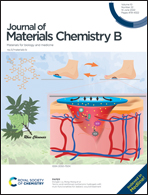Preparation and characterization of photocurable composite extracellular matrix-methacrylated hyaluronic acid bioink
Abstract
Producing a bioink that fulfills the physicochemical requirements of printing and provides a desirable environment for encapsulated cells is a major challenge in three-dimensional (3D) bioprinting. Thus, we have developed a biocompatible bioink (ECM@MeHA bioink) with suitable mechanical support and visible light printable properties. In this bioink system, the thermosensitive extracellular matrix (ECM) was prepared and can be crosslinked at 37 °C. And the prepared methacrylated hyaluronic acid (MeHA) can be crosslinked under visible light using the biosafe initiators (Eosin Y, TEOA, and NVP). Thus, the ECM@MeHA bioink consisted of a mix solution of ECM and MeHA containing visible light initiators can cure at 515 nm visible light for 30 s and then further crosslinked at 37 °C to form a double network hydrogel. Then, the mechanical properties and biocompatibility of ECM@MeHA hydrogel, and the printability and the cell viability of the ECM@MeHA bioink were systemically evaluated. The results showed that the mechanical property of the MeHA hydrogel is significantly improved following the addition of 10 mg mL−1 of ECM (10ECM@MeHA). The compressive strength and modulus of 10ECM@MeHA hydrogel were 102.38 ± 5.27 kPa and 782 ± 20.36 kPa, which were 2.7 times and 3.1 times higher than those of MeHA, respectively. After encapsulating MC3T3-E1 cells in the 10ECM@MeHA hydrogel for 7 days, the culture showed excellent biocompatibility. The 10ECM@MeHA bioink and cell–laden 10ECM@MeHA bioink were printed, and the cells were successfully encapsulated by the extrusion-based bioprinting and digital light processing (DLP) -based bioprinting. The cell–laden 10ECM@MeHA scaffold showed 94.27 ± 3.00% cell viability after 7 days of the 3D culture. In conclusion, 10ECM@MeHA bioink may provide a new strategy for constructing disease models or drug screening models in vitro and is expected to be widely used in the field of tissue engineering scaffolds.



 Please wait while we load your content...
Please wait while we load your content...